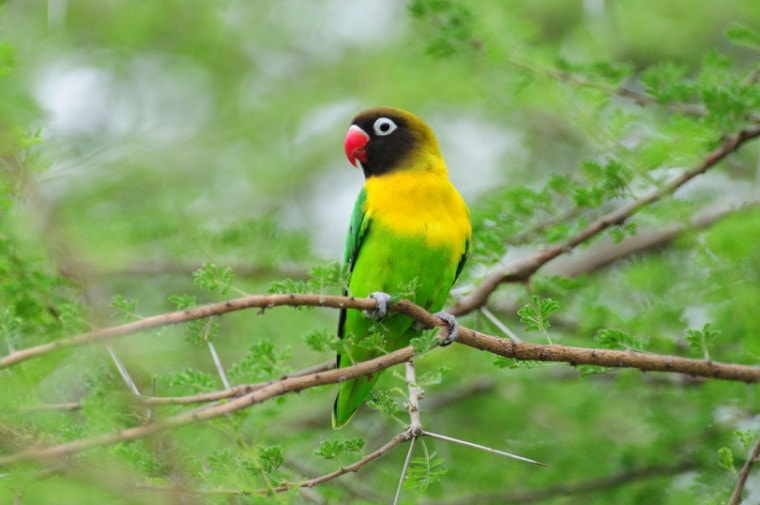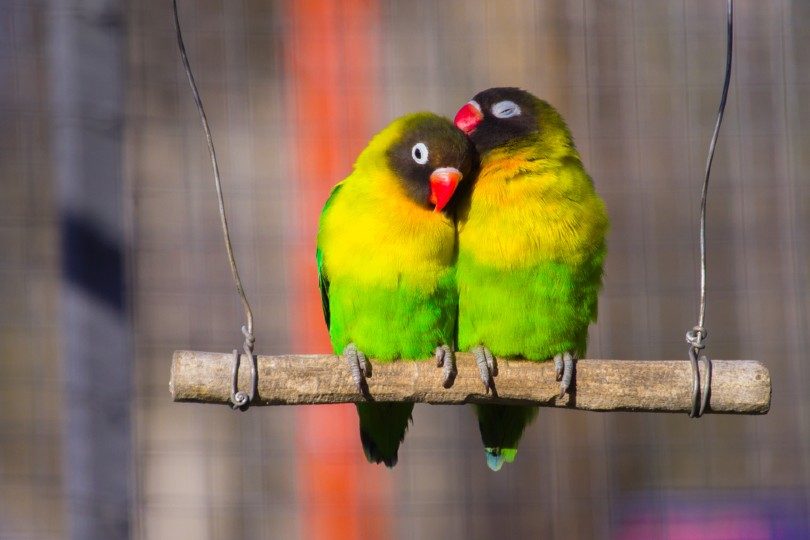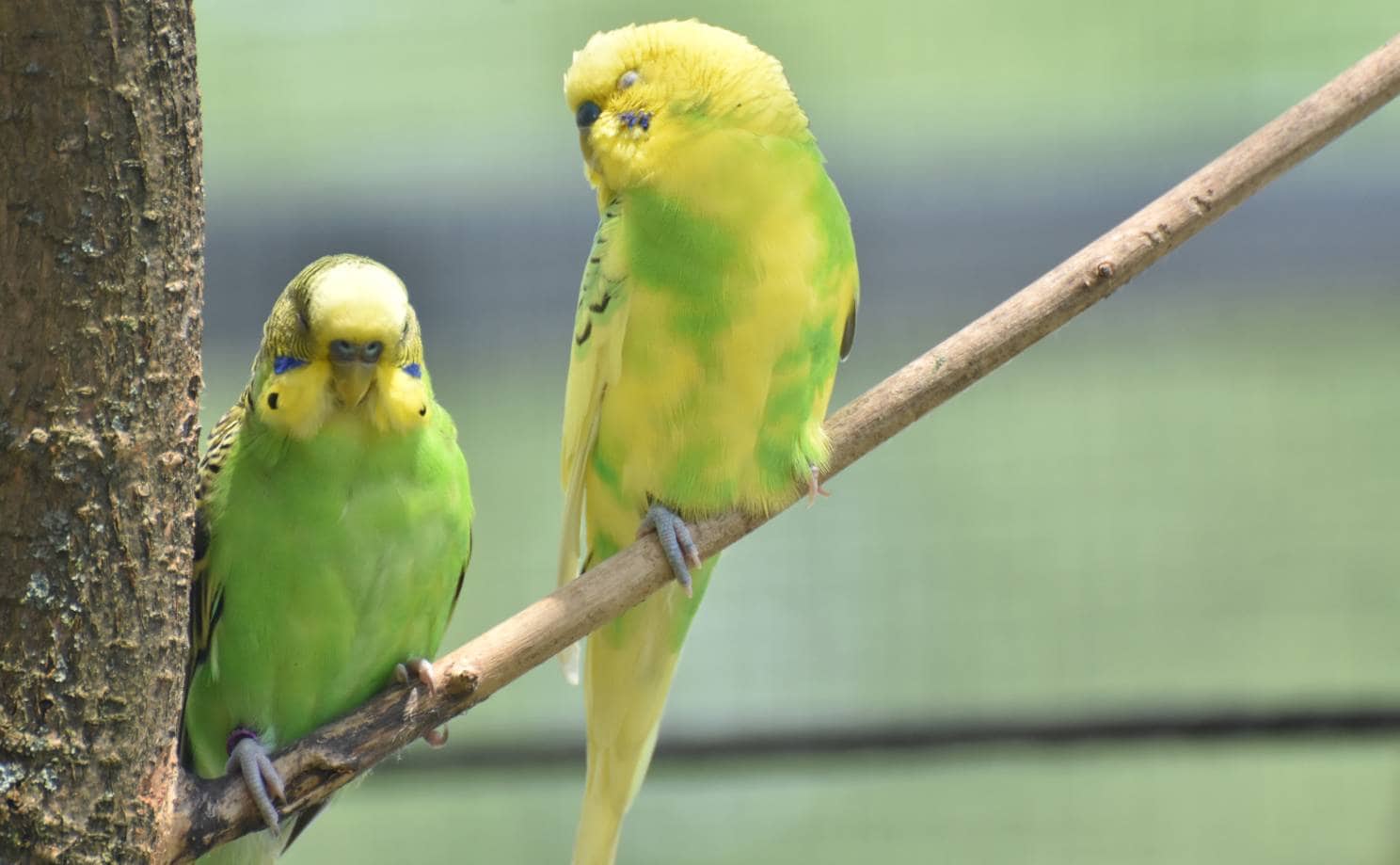
The Lovebird is one of the smaller parrot species commonly kept as pets, known for the strong bonds that they form with their owners and other Lovebirds. They are intelligent, lively, beautiful, and available in a variety of color mutations, both from selective breeding and naturally in the wild.
The Black-Collared Lovebird is rarely kept in captivity due to their special dietary needs, which come mostly from the native fig in their natural environment. Without this fig as their base diet, these birds do not survive long in captivity and as such, are relatively unknown in the pet industry.
 Species Overview
Species Overview

| Common Names: | Black-Collared Lovebird, Swindern’s Lovebird |
| Scientific Name: | Agapornis swinderniana |
| Adult Size: | 4–5 inches |
| Life Expectancy: | 10-15 years |
Origin and History
The Black Collared Lovebird is native to equatorial Africa in the forests of Cameroon, the Democratic Republic of Congo, and Ghana, where they hide high in the canopy of the forest and are exceedingly difficult to find. They were first discovered by German naturalist and zoologist Heinrich Kuhl in 1820, who was the assistant professor to the Dutch professor Theodore van Swinderen of Groningen University, whom he named the species after.
These birds have a large range, in which they have a large population. Since they are not common in the pet industry, they are not under any significant threat.

Temperament
Since these birds are rarely, if ever, kept as pets, there is little known about their personality or potential as pets. Lovebirds in general, though, are mild-mannered birds and are generally friendly, docile, inquisitive, and seemingly always on the go. They usually form strong bonds with their owners, although if they’re kept in mating pairs, they typically will avoid human interaction because they are so focused on each other. A single Lovebird needs plenty of interaction with their owners and entertainment in the form of toys, ladders, and swings.
Speech & Vocalizations
In general, most Lovebirds are vocal birds that make loud, screeching, high-pitched noises that can become overwhelming at times. This noise is usually mitigated by regular interaction and making sure your Lovebird is not bored or by getting them a partner, although this may prove to make them noisier because they will chatter away to each other! Lovebirds are not known for mimicking speech much and typically only learn a handful of words at most, but they do mimic other sounds in their environment.
Little is known about Black-Collared Lovebirds in captivity, but their speech and vocalizations will likely be much the same.
Black-Collared Lovebird Colors and Markings
The Black-Collared Lovebird is typically 4–5 inches tall, including the tail. Their plumage is mostly light green, with more yellow-green coloring on their back, chest, and neck. They have a distinctive black half collar on the nape of their neck, from which they derive their common name, with bright red and blue markings on their tail. Males and females are similar in appearance and difficult to tell apart.
There are two other sub-species of the Black-Collared Lovebird:
 Caring for the Black-Collared Lovebird
Caring for the Black-Collared Lovebird
Since so little is known about the captive care of these birds, it’s difficult to determine their exact needs, but the same care requirements would likely be needed as other Lovebird species. Lovebirds are generally easy birds to care for, and they are far less destructive, noisy, and territorial than their larger cousins.
They do need proper socialization, though, because otherwise, they are known to bite and act aggressively toward other birds and pets. They are also active animals and need plenty of mental and physical stimulation to stay happy and healthy. These birds love to chew, so they need to be provided with plenty of chew toys or paper to tear up. You’ll need to keep a close eye on them when they are let outside their cage!
Diet and Nutrition
Black-Collared Lovebirds require native fig seed or fig flesh as a staple in their daily diet, which is almost impossible to provide for them outside of their natural habitat. Without this, they cannot thrive or breed in captivity, and many will soon die without these figs. It’s for this reason that these birds have not become pets in the United States or Europe, and many experts believe that they cannot be adapted to captive life. They also feed on small insects, larvae, and various native seeds found in the area.
Where to Adopt or Buy a Black-Collared Lovebird
Since they cannot breed, thrive, or possibly even survive without their native figs, Black-Collared Lovebirds are not kept as pets, and none are available for purchase. That said, several other Lovebird species are commonly kept as pets and are easily available from breeders and adoption organizations. The Peach-Faced Lovebird is a common variety kept as a pet, as are the Fischer’s Lovebird and Black-Masked Lovebird. These typically range in price from as little as $25 to $100.
 Final Thoughts
Final Thoughts
Lovebirds are great pet birds overall because they are small, affectionate, easy to care for, and a great choice for beginners. Some species are endangered, though, and there are only three species that are kept as pets. The Black-Collared Lovebird is a rare beauty, and this is all the more emphasized by the fact that these birds are rarely, if ever kept, as pets. They can only be observed and appreciated in their natural habitat.
Related Reads:
Featured Image Credit: Rich Lindie, Shutterstock
 Species Overview
Species Overview Caring for the Black-Collared Lovebird
Caring for the Black-Collared Lovebird





